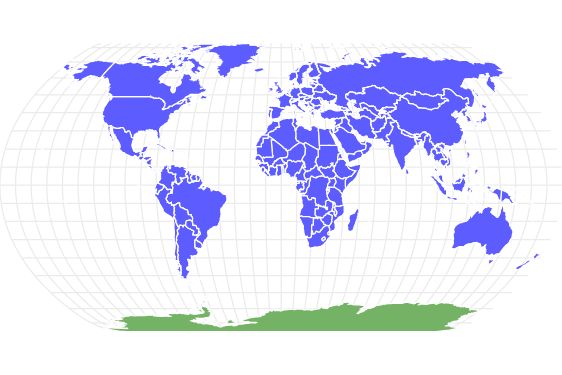Mosquito
Only the female mosquito actually sucks blood
Advertisement
Mosquito Scientific Classification
Mosquito Facts
- Prey
- Nectar, honeydew, plant juices, and blood
- Name Of Young
- Larvae
- Group Behavior
- Solitary
- Fun Fact
- Only the female mosquito actually sucks blood
- Biggest Threat
- Habitat destruction
- Most Distinctive Feature
- Piercing mouthpart
- Other Name(s)
- Mitsy, mossy, drill bug
- Gestation Period
- A few days
- Litter Size
- 100-200 eggs
- Predators
- Mammals, amphibians, reptiles, birds, and other insects
- Diet
- Omnivore
- Type
- Insect
- Common Name
- Mosquitoes
- Number Of Species
- 3500
- Location
- Worldwide
View all of the Mosquito images!

Mosquitoes have been a scourge of humanity for thousands of years.
They sometimes carry dangerous diseases, including malaria, yellow fever, West Nile, dengue fever, and Zika, which are responsible for numerous deaths every year. But the mosquito family is a very diverse bunch, and only a small percentage of species actually consume human blood.
Most of the rest are completely harmless to people. This article will cover some interesting facts about the reality of these often annoying but still misunderstood insects, including their life cycle, physical description, and diet.
3 Incredible Mosquito Facts!
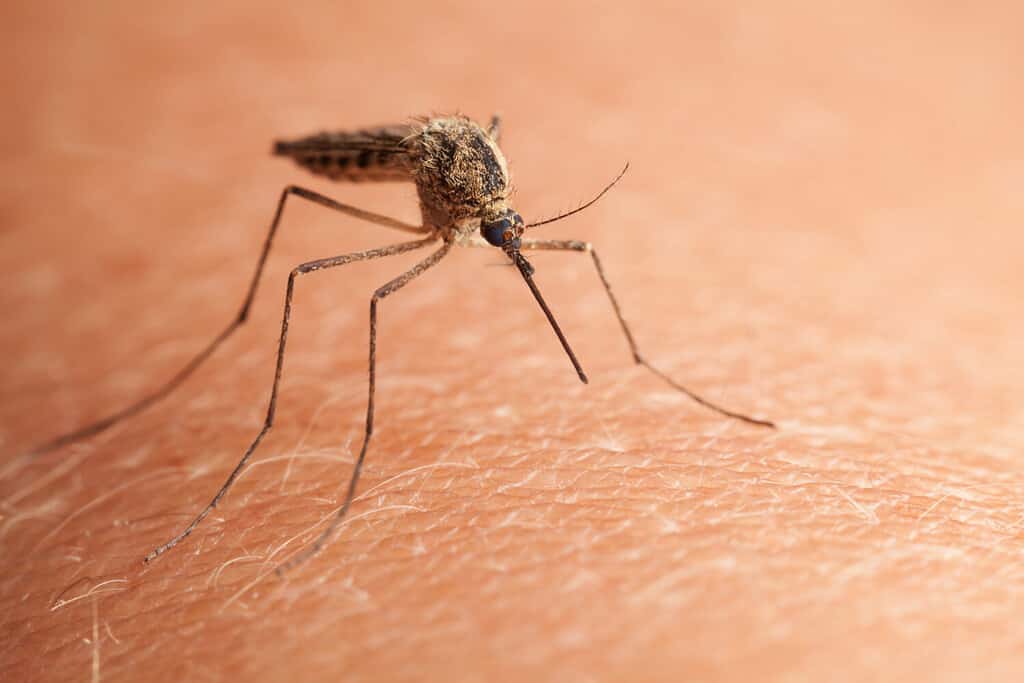
There are over 3,500 mosquito species across the world
©Anest/Shutterstock.com
- The name mosquito actually means little fly in Spanish and Portuguese, which perhaps doesn’t entirely fit their description.
- Females tend to lay their eggs in stagnant shallow water or damp soil.
- Some mosquitoes are attracted to carbon dioxide, lactic acid, and octanol present in their breath and sweat. One of the most interesting facts is that they apparently seek out beer drinkers, although it’s not entirely understood why.
Evolution and Origins
It originated as a feral species that primarily feeds on animals in the forested regions of sub-Saharan Africa. Even today, the subspecies Ae. aegypti formosus can still be found in these forests, where it continues to bite non-human animals.
Scientific research indicates that mosquitoes share a common family with the housefly. Approximately 200 million years ago, mosquitoes began their evolutionary journey, eventually transforming into the blood-sucking insects we are familiar with today.
Following a blood meal, the female mosquito deposits her eggs in or close to water, soil, and near the roots of certain plants in locations that are prone to water accumulation.
These eggs are capable of enduring dry environments for several months. Once immersed in water, the eggs hatch, giving rise to mosquito larvae, often referred to as “wrigglers.”
Species, Types, and Scientific Names

The scientific name for the mosquito family is Culicidae.
©jiade/Shutterstock.com
The scientific name for the mosquito family is Culicidae. This comes from the Latin word culex for a midge or gnat. More than 3,500 species have been recorded across 112 different genera, although it would be difficult to list all of the different types here. Mosquitoes are a member of the fly order Diptera.
Here are the most common types:
- Asian tiger mosquito
- Yellow fever mosquito
- Aedes
- Common house mosquito
- Marsh mosquitoes
- Culex
- Psorophora ciliata
- Mansonia
- Toxorhynchites
- Culicidae
- Culiseta annulata
- Culiseta
- Eretmapodites
- Culicinae
- Haemagogus
- Psorophora
- Coquillettidia
- Toxorhynchitinae
Appearance: How to Identify Them
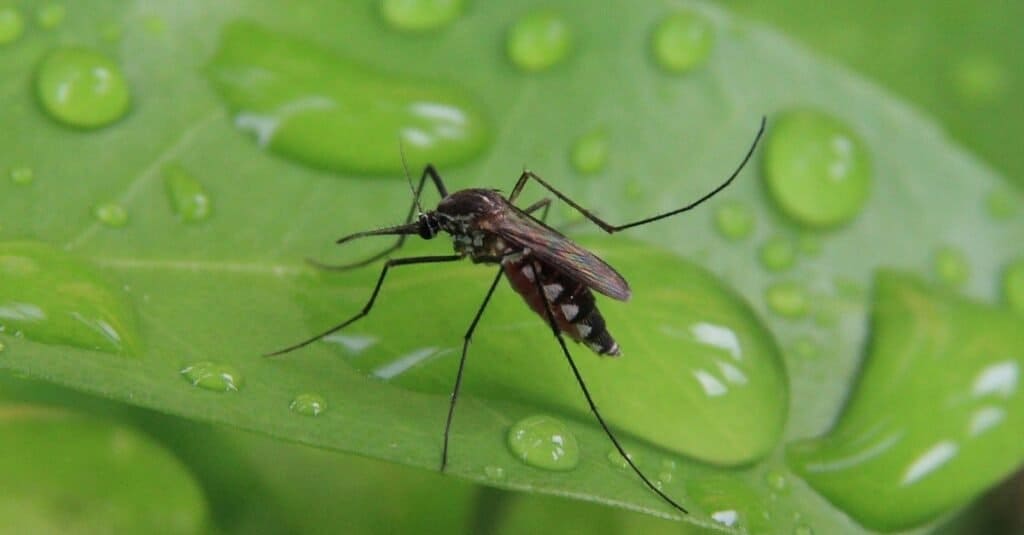
Mosquitoes experience a series of four distinct life stages: eggs, larvae, pupae, and adults.
©iStock.com/arachi07
Mosquitoes undergo four different life stages: eggs, larvae, pupas, and adults. The adults can be identified by the slender body, the long and sinewy legs, the pair of wings extending from the middle of the thorax, and the long proboscis that forms part of the mouth. Most species are less than an inch long and difficult to see.
Sometimes you’re more likely to hear their buzzing sound than you are to catch a glimpse of the mosquito itself. The larvae, by contrast, look nothing like the adult. It is characterized by a long body with eight abdominal segments, tiny mouth brushes, and no legs. The pupa looks kind of like a big sac and remains stationary near the water’s surface for a few days. While the larvae and pupas live in shallow water, they still must draw in air to survive.
Habitat: Where to Find Them

In colder regions, northern populations have a tendency to endure the winter season by seeking refuge in structures or the hollows of trees.
©Roziline/Shutterstock.com
Mosquitoes live in just about every type of habitat all over the world outside of Antarctica, but the greatest concentration can be found in warm tropical environments closer to the equator. Northern populations tend to survive the winter by taking shelter in buildings or hollow trees.
Diet: What Do Mosquitoes Eat?
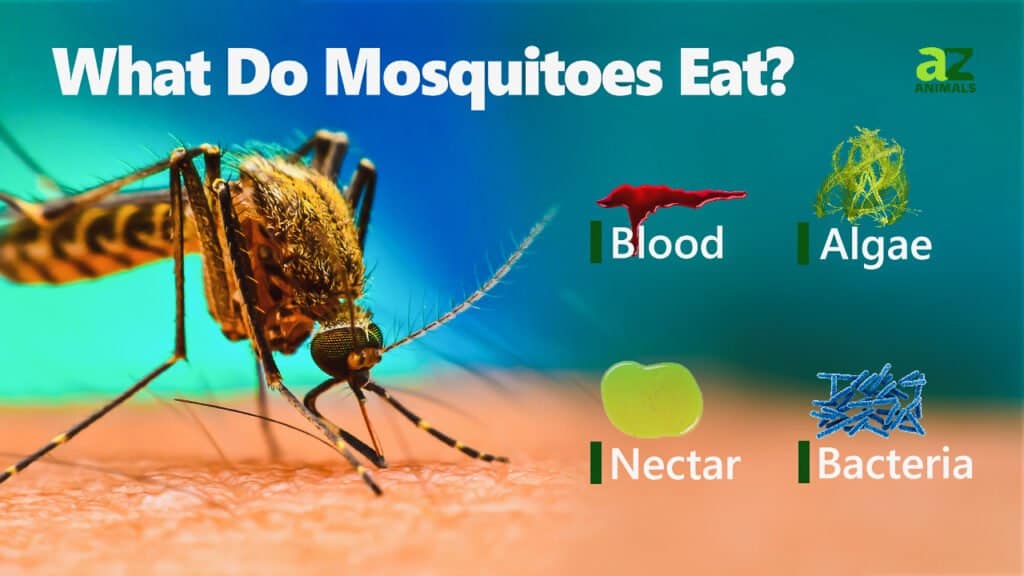
Despite their reputation as blood-sucking insects, mosquitoes actually have a very fascinating diet, which will be covered below.
What eats the mosquito?
Mosquitoes are preyed upon by all kinds of different fish, birds, amphibians, reptiles, and even other insects. One of the most common predators is the dragonfly. They feed on mosquito eggs and larvae in the water.
What does the mosquito eat?
Adult mosquitoes actually consume nectar, honeydew, and plant juices. Only the females suck blood (the technical term for this is hematophage), and even then the blood is intended for the eggs. Their sharp mouthparts are specialized for piercing skin or drawing out nectar from plants. The larvae, by contrast, consume algae and bacteria. The pupas may not feed at all.
Prevention: How to Get Rid of Them
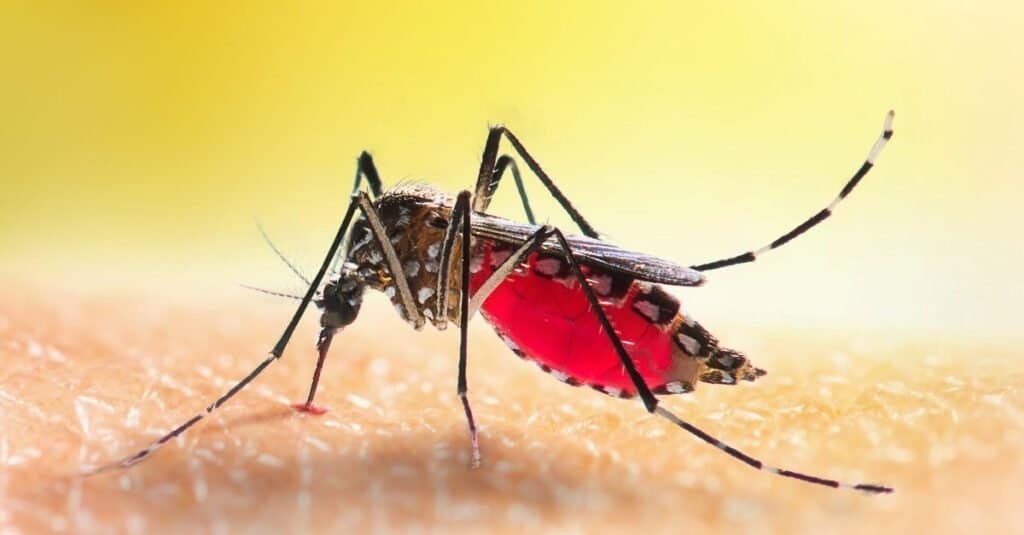
To protect yourself from mosquito bites outdoors, you have various options like bug sprays, zappers, citronella torches/candles, and natural repellents such as rosemary, peppermint, and lemon thyme.
©iStock.com/panom
These insects can be tricky to deal with. If you have an infestation in your home, then you should first check any sinks, closets, or furniture for damp, humid places where they can spawn, and repair any damaged window screens to prevent them from entering in the first place. EPA-registered insect repellent in the fogger, aerosol, or pump spray form can kill individual mosquitoes as well.
When you’re going outside, there are all kinds of options to prevent bites, including bug sprays, zappers, citronella torches or candles, and natural repellents such as rosemary, peppermint, and lemon thyme. Once applied to clothing and exposed skin, sprays can be effective for up to 10 hours at a time.
The Centers for Disease Control and Prevention lists four chemicals as being effective mosquito repellents: DEET, Picaridin, IR3535, and PMD/oil of lemon eucalyptus. Strong fans can also keep mosquitoes from flying close to you.
If you are facing a wider infestation, then consider using some kind of pesticide on the problem area and also try to remove any stagnant water on your property to prevent them from spawning in the future. Particularly tricky infestations may require the help of a specialist.
Have you ever wondered what would happen if mosquitos went extinct? Read here to find out!
View all 164 animals that start with MMosquito FAQs (Frequently Asked Questions)
Are mosquitoes dangerous?
Mosquitoes are not dangerous to people on their own, but they can spread dangerous pathogens that make people sick with diseases.
How many legs does the mosquito have?
Like all insects, the mosquito has six long legs extending from its body.
How do you identify mosquitoes?
A description of the adult mosquito is rather simple: it has a slender body, six legs, and only two wings on the thorax. This sets them apart from flies (which have more compact bodies) and dragonflies (which have multiple pairs of wings). Colors tend to be either black or brown.
How do you get rid of mosquitoes?
Some kind of repellent or spray is a quick and easy solution that works in most circumstances. If you are attempting to get rid of a wider infestation, then you should consider removing any stagnant water or using pesticides.
How do I get rid of mosquito bites?
There are a few treatments you can try at home, including calamine lotion, hydrocortisone cream, baking soda and water, an ice pack or moist cloth, or (for stronger reactions) an oral antihistamine. Only if you develop a fever should you make an appointment with a doctor.
Why do mosquito bites itch?
The mosquito’s saliva contains an anti-coagulant which helps prevent blood clots to suck up more blood. This saliva usually provokes an allergic reaction in people.
How long do mosquito bites last?
Itching and redness can last for three or four days, while swelling can last up to a week.
What smells do mosquitoes hate?
As mentioned previously, mosquitoes tend to be repelled by some natural oils such as citronella, peppermint, and lavender.
What are mosquitoes attracted to?
Mosquitoes are attracted to carbon dioxide, lactic acid, and octenol found in breath and sweat.
Why do mosquitoes drink blood?
Blood contains protein and iron that some female mosquitoes need to produce eggs.
What is the biggest mosquito in the world?
The largest mosquito in the world is perhaps the Australian elephant mosquito. It can measure about 1.5 inches long.
How long does a mosquito live?
The typical lifespan of a mosquito from eggs to adults may only last seven to 10 days. However, there are a few species that may have a lifespan of weeks or even months.
Can we live without mosquitoes?
Technology has made it possible to eliminate the most dangerous pathogen-carrying mosquitoes by introducing modified sterile individuals into a population. However, it’s unlikely this technique would ever be used outside of a few of the worst species, because, as annoying as they can be, mosquitoes are important parts of the overall ecosystem. They provide food for other animals, so it’s a good idea to keep them around.
What animals eat mosquitoes?
Mosquitoes have a huge list of potential predators. Dragonflies, fish, lizards, and geckos are probably the most common. But any small predatory animal that eats insects may target the mosquito.
Why do mosquitoes bite some people more than others?
As mentioned previously, mosquitoes may be attracted to various substances produced by the body, including carbon dioxide and lactic acid, as well as excessive body heat. Beer drinkers, exercisers, and pregnant women may be most at risk here. Another big factor may be blood type. Mosquitoes appear to be attracted most to Type O blood, followed by Type B and then Type A. Mosquitoes can actually “read” a person’s blood type by chemical signals secreted by the body. About 15% of people do not secrete this chemical signal, and mosquitoes are more likely than not to avoid them, regardless of blood type. Finally, mosquitoes might be more attracted to people with lots of skin bacteria.
How many mosquitos are there?
As many as 110 trillion mosquitoes exist in the world today. This works out to almost 16,000 mosquitoes per human!
What are the differences between mosquitoes and no-see-ums?
The key differences between no-see-ums and mosquitoes include size, distribution, appearance, mouthparts, wings, and larvae survival.
What are the key differences between a male mosquito and a female mosquito?
The key differences between a male mosquito and a female mosquito are physical appearance, buzzing sounds, personalities and roles, and lifespan.
Thank you for reading! Have some feedback for us? Contact the AZ Animals editorial team.
Sources
- Smithsonian Magazine, Available here: https://www.smithsonianmag.com/science-nature/14-not-so-fun-facts-about-mosquitoes-36242998/
- Orkin, Available here: https://www.orkin.com/pests/mosquitoes/what-do-mosquitoes-eat
- Home Depot, Available here: https://www.homedepot.com/c/ab/how-to-get-rid-of-mosquitoes/9ba683603be9fa5395fab90c4977a49
- Mayo Clinic, Available here: https://www.mayoclinic.org/diseases-conditions/mosquito-bites/diagnosis-treatment/drc-20375314
- Smithsonian Magazine, Available here: https://www.smithsonianmag.com/science-nature/why-do-mosquitoes-bite-some-people-more-than-others-10255934/

